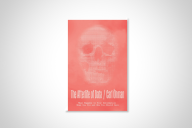You have /5 articles left.
Sign up for a free account or log in.
Standing in line at the drugstore a couple of weeks ago, I spied on the magazine rack nearby this month’s issue of National Geographic – conspicuous as one of the few titles without a celebrity on the cover. Instead it showed a photograph of an infant beneath a headline saying "This Baby Will Live to Be 120."
The editors must have expected disbelief, because there was a footnote to the headline insisting that the claim was not hype: "New science could lead to very long lives." When was the last time you saw a footnote in a popular periodical, on the cover, no less? It seemed worth a look, particularly after the septuagenarian in front of me had opened complex, in-depth negotiations with the pharmacist.
The headline, one learns from a comment on the table of contents, alludes to a traditional Jewish birthday wish or blessing: "May you live to be 120." This was the age that Moses was said to have reached when he died. The same figure appears -- not so coincidentally perhaps – at an important moment in the book of Genesis. Before sending the Flood, Jehovah announces that man’s lifespan will henceforth peak at 120 years. (I take it there was a grandfather clause for Noah. When the waters recede, he lives another 350 years.)
The cap on longevity, like the deluge itself, is ultimately mankind’s own fault, given our tendency to impose too much on the Almighty’s patience and good humor. He declares in about so many words that there is a limit to how much He must endure from any single one of us. Various translations make the point more or less forcefully, but that’s the gist of it. Even 120 years proved too generous an offer – one quietly retracted later, it seems. Hence the Psalmist’s lament:
“The days of our years are threescore years and ten; and if by reason of strength they be fourscore years, yet is their strength labor and sorrow; for it is soon cut off, and we fly away.”
Nursing homes are full of people who passed the fourscore marker a while ago. If you visit such places very often, as I have lately, “May you live to be 120” probably sounds more like a curse than a blessing. Not even a funeral obliges more awareness of mortal frailty. There is more to life than staving off death. The prospect of being stranded somewhere in between for 30 or 40 years is enough to make an atheist believe in hell.
Meanwhile, in science…. The medical and biological research surveyed in that NatGeo article promises to do more than drag out the flesh’s “labor and sorrow” a lot longer. The baby on the magazine cover will live his or her allotted span of six score decades with an alert mind, in a reasonably healthy body. Our genetic inheritance plays a huge but not absolutely determinate role in how long we live. In the wake of the mapping of genome, it could be possible to tinker with the mechanisms that accelerate or delay the aging process. It may not be the elixir of youth, but close enough.
Besides treating the same research in greater depth, Ted Anton’s The Longevity Seekers: Science, Business, and the Fountain of Youth (University of Chicago Press) emphasizes how profound a change longevity research has already wrought. It means no longer taking for granted the status of aging as an inescapable, biologically hardwired, and fundamentally irreversible process of general decline. Challenging the stereotypes and prejudices about the elderly has been a difficult process, but longevity engineering would transform the whole terrain of what aging itself entails.
Anton, a professor of English at DePaul University, tells the story in two grand phases. The first bears some resemblance to James Watson’s memoir The Double Helix, which recounts the twists and turns of laboratory research in the struggle to determine the structure of DNA – work for which he and Francis Crick received a Nobel Prize in medicine in 1962. Watson’s book is particularly memorable for revealing science as an enterprise in which personalities and ambitions clash as much as theories ever do. (And with far more rancor as Watson himself demonstrated in the book’s vicious and petty treatment of Rosalind Franklin, a crystallographer whose contribution he downplayed as much as possible.)
A practitioner of long-form journalism rather than a longevity researcher, Anton writes about conflicts in the field with some detachment, even while remaining aware that the discoveries may change life in ways we can’t yet picture. The initial phase of the research he describes consisted largely of experiments with yeast cells and microscopic worms conducted in the 1990s. Both are short-lived, meaning that the impact of biochemical adjustments to their genetic “thermostats” for longevity would register quickly.
During the second phase of Anton’s narrative, lab research involved more complex organisms. But that that was not the most important development. The public began hearing news flashes that scientists had discovered that the key to a longer life was, say, restricted caloric intake, or a chemical called resveratrol found in red wine. Findings presented in scientific journals were reported on morning news programs, or endorsed on Oprah, within days or even hours of publication. Hypotheses became hype overnight.
This generated enthusiasm (more for drinking red wine than restricting calories, if memory serves) as well as additional confidence that biotechnological breakthroughs were on the way. Everybody in longevity research, or almost everybody, started a company and ran around looking for venture capital. Models, evidence, and ideas turned proprietary information -- with the hurry to get one’s findings into professional journals looking more and more like the rush to issue a press release.
So far, no pharmaceutical has arrived on the market to boost our lifespans as dramatically as the worm and yeast cells in the laboratory worms. “The dustbin of medical breakthroughs,” Anton reminds us, “bears the label ‘It Worked in Mice.’ ” On the other hand, the research has been a boon to the cosmetics industry.
As it is, we’re nowhere near ready to deal with the cumulative effect of all the life-extending medical developments from the past few decades. The number of centenarians in the world “is expected to increase tenfold between 2010 and 2050,” the author notes, “and the number of older poor, the majority of them women,” is predicted “to go from 342 million today to 1.2 billion by that same year.”
But progress is ruthless about doing things on its own terms. Biotech is still in its infancy, and its future course -- much less its side effects -- is beyond imagining. The baby on the magazine cover might well live to see the first centenarian win an Olympic medal. I wish that prospect were more cheering than it is.








